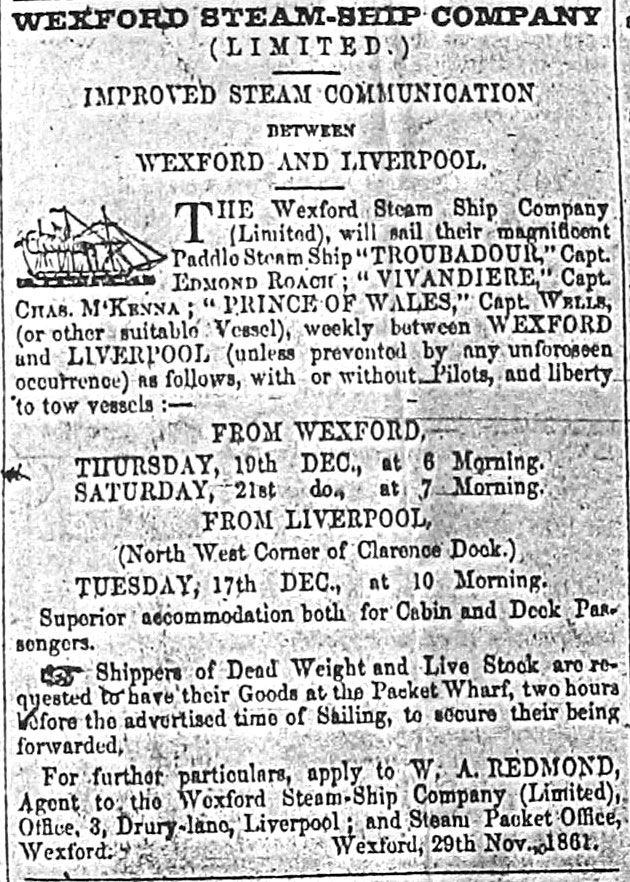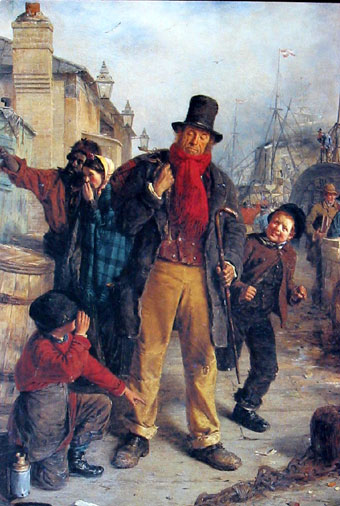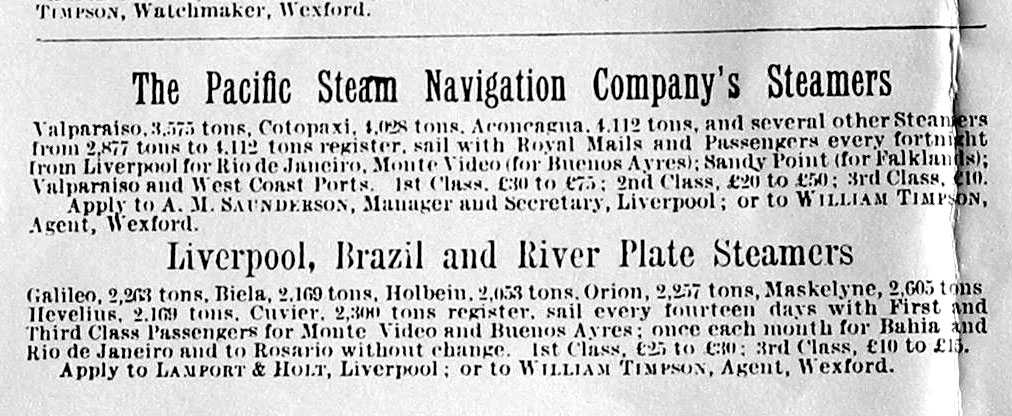
MGWR timetable sheet for the Galway line, December 1853
(Mulligan 1983) |
Once
in Dublin, emigrants would stay a night at a local hotel.
The Broad Stone Hotel was the establishment of the Royal
Canal Company in Dublin. In October 1807, under the management
of John Rooney, the fare for one bed for one person in
a room containing two or more beds was 2s-2d.
In
order to cross the Irish Sea from Dublin to Liverpool,
there were at least three boats daily and the journey
took twelve to fourteen hours. There was a fully developed
shipping trade between Ireland and Liverpool. The first
quarter of the nineteenth century witnessed technological
developments in the application of steam power to shipping
which led to the strengthening of the connection between
Ireland and England. From the 1820s onward, ‘Liverpool
was connected with all the main Irish ports by a fleet
of relatively fast, cheap steam vessels, mainly paddle-driven
but some screw-driven […]. The leading company of the
Dublin-Liverpool trade was the Dublin and Liverpool Steam
Packet Co. According to the company’s estimate, ‘they
carried more than 100,000 passengers from June 1853 to
June 1854’ [Préteseille 1999]. The crossing was a traumatic
experience for passengers. There was little cabin accommodation.
Moreover, ‘most ships were carrying animals below deck
and they were usually taken better care of.’ William Watson,
managing director of the Dublin and Liverpool Steam Packet
Company gave evidence when he was questioned by a Parliamentary
Committee:
–
If you have both cattle and passengers you give the cattle
preference?
– We cannot have them both in the same places.
– But the cattle would be sheltered, and deck passengers
would not be sheltered?
– Yes [Préteseille 1999]
Few
ships had steerage accommodations so most passengers had
no shelter. They were therefore exposed to the weather
and often arrived exhausted, scarcely able to walk. Most
of the time, steamers – whose average tonnage was 500
to 700 – were overcrowded. Other emigrants bound to Liverpool
sailed in boats headed to Holyhead, and then travelled
by stagecoach to Liverpool (about 145 km).
Emigrating
from Co. Wexford
Already
in the late seventeenth century, Wexford was an international
port with heavy trade to Liverpool, Dublin, Bristol, and
other ports of the British isles and the continent. The
modern quay front ‘began to take shape in the early part
of the [19th] century’ [Rossiter 1989: 13].
The Quay Corporation was responsible for the maintenance
of the many wharfs and quays, as well as the pilotage
control, piped water supply, and cleansing of the streets.
The Quay Corporation ‘had the power to levy rates on vessels
using the port’ [13]. Later in the 1830s, ‘the Redmond
family opened a dockyard in Wexford causing Lewis, in
his Topography of Ireland to remark: “Shipping interests
have been materially promoted by the construction of a
patent slip and shipbuilding yard at the southern end
of his embankment”’ [14]. Wexford town was well connected
to the county villages and townlands through Bianconi
and carts.
| 
Wexford Town Library
|
From
Wexford Quay there were steamer-boats sailing directly
to Liverpool. In 1861, the Wexford Steam-Ship Co.
sailed ‘their magnificent paddle steam ships Troubador
(Capt. Edmond Roach); Vivandiere (Capt. Chas. McKenna);
Prince of Wales (Capt. Wells); or other suitable
vessel, weekly between Wexford and Liverpool’ [The
People 28 December 1861]. Departures from Wexford
were every Thursday at 6.00 A.M. and Saturday at 7.00
A.M., with an estimated sail time of twelve hours. There
were accommodations for cabin and deck passengers. Other
choice was to sail to Dublin and from there to Liverpool
(British & Irish Steam-Packet Co.).
In
the 1880s, Lamport & Holt’s agent in Wexford was William
Timpson, who would sell tickets to Liverpool with connections
to the River Plate sailing every fourteen days [Bassett
1885, 104].
The
Liverpool Experience
A
dreadful experience awaited those disoriented Irish arriving
in Liverpool in order to get a passage to South America.
Indeed the arrival in Liverpool did not guarantee the
next leg of the journey. Some of Liverpool residents were
notorious for tricking the inexperienced travellers out
of their passage money or even seducing women emigrants
into employment in the city’s brothels. During the Famine
period, ‘ma notorious for tricking the inexperienced travellers out
of their passage money or even seducing women emigrants
into employment in the city’s brothels. During the Famine
period, ‘many rural emigrants never escaped the slums
of Liverpool. The Irish now had to survive the streetwise
con-men and racketeers’ [Préteseille 1999]. Before getting
on board, emigrants had to deal with ship-brokers, runners,
boarding-house keepers who overcharged them, keepers of
spirit vaults and provision stores who sold them bad food
and drink at high prices. They also had to pass a medical
inspection.
| 
Erskine Nicol (1825-1904), Scottish, An Irish
Emmigrant Landing at Liverpool, 1871 (National
Gallery of Scotland, Edinburgh)
|
When
arriving at Liverpool, emigrants from Dublin and Wexford
landed in Clarence Dock. Since most of the emigrants bound
to Argentina would have already purchased their tickets
in Ballymahon, Mullingar or Wexford town, their money
was secured and just had to take care of their lodging
until the boarding time. During the days of sailing ships,
vessels were ‘expected any day now’ and, if the wind was
against them, they could be up to three weeks late. From
the many boarding-houses in Liverpool, those for poor
emigrants were to be found in the neighbourhood of Waterloo
Dock and northwards of the Clarence Dock, ‘more especially
about Denison Street, Regent Street, Carlton Street, Porter
Street, Stewart Street, and Great Howard Street’ [Préteseille
1999].

Bassett's Wexford County Guide and
Directory (1885)
Wexford Town Library |
|


